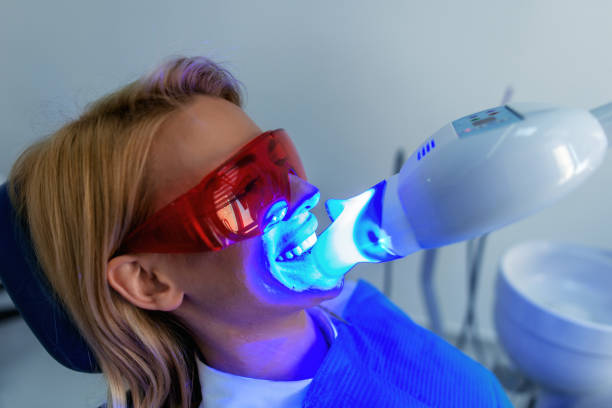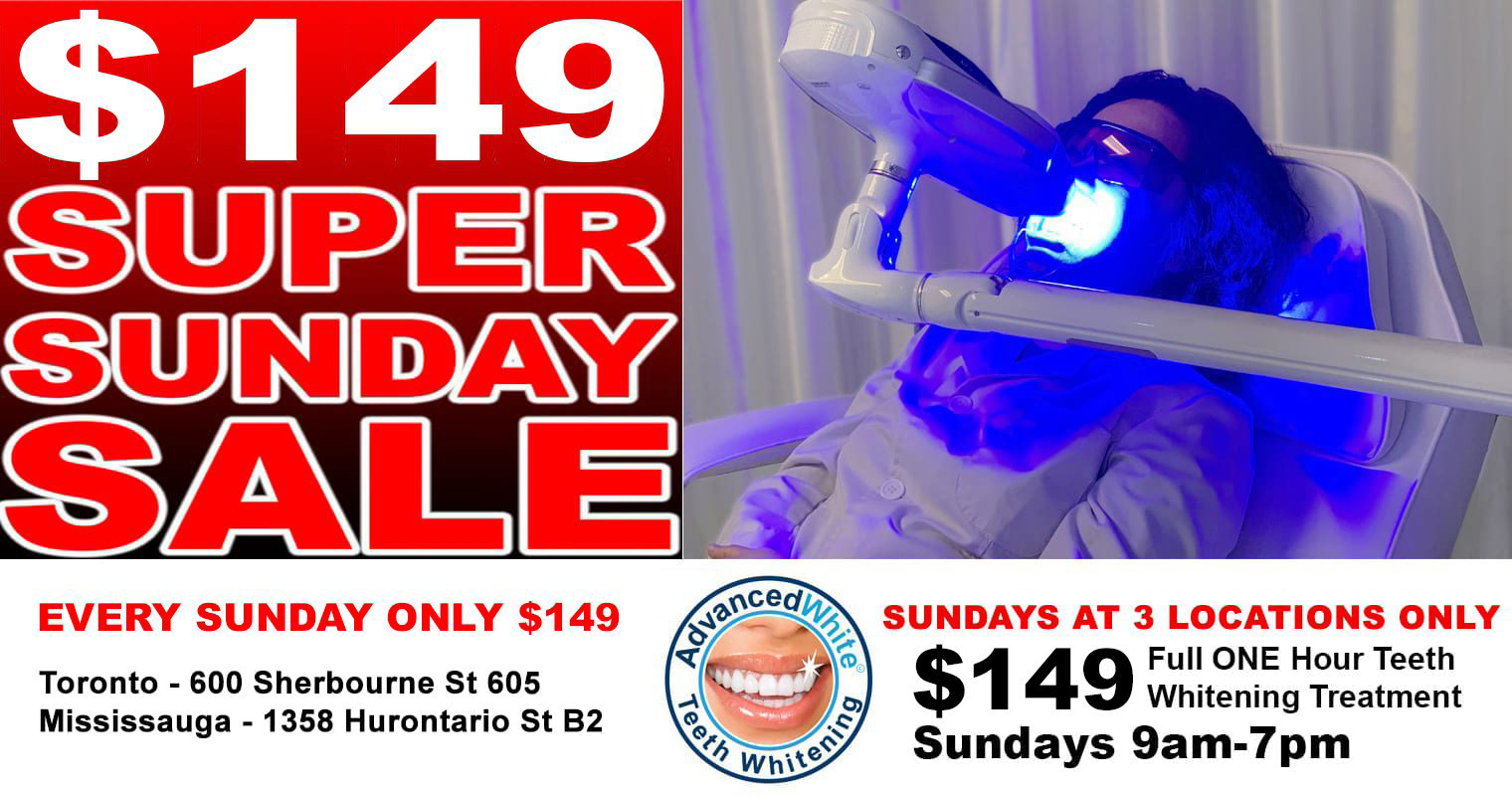Table of Contents
Teeth Whitening Toronto
Teeth whitening refers to a range of procedures designed to enhance the brightness and whiteness of someone’s natural teeth. Sanding away stains, bleaching, UV light therapy, and other systems are all used to whiten teeth.
You can try various methods at home in Toronto in addition to the wide variety of teeth-whitening products offered. You can also get your teeth whitened at your Toronto dentist’s office.
Some teeth whitening techniques might have unpleasant side effects, particularly tooth sensitivity and gum inflammation. We’ll look at how tooth whitening functions, safe practices, and any adverse effects.
Types of teeth stains
You must select a whitening technique that targets the kind of stains you have if you want to whiten your teeth effectively. For example, if you have both intrinsic and extrinsic stains (see below), you’ll probably need to pick a whitening technique that safely treats each type.
Consider speaking with your dentist if you are unsure about your discoloration type. They can advise you on the different types of stains on your teeth and the best treatment options.
intrinsic stains
Intrinsic stains are those that are located deep within the enamel of your teeth. When you are a child, intrinsic staining can occasionally be seen before your teeth sprout from your gums.
These stains can be brought on by antibiotics, fluoride exposure, and thinning tooth enamel with age. In certain situations, intrinsic staining may even be genetic, suggests a study from 2014.
Extrinsic stains
Extrinsic stains are found on your teeth’s surface. These occur due to environmental exposure to elements that stain the enamel of your teeth. For example, smoking, coffee, and artificial food colouring can generate this kind of discoloration.
According to research in 2014, extrinsic stains could also be connected to antibiotic use, just like intrinsic stains.
Options for whitening teeth in Toronto
Options for teeth whitening include professional teeth whitening procedures supervised by your dentist and toothpaste with whitening chemicals.
Some teeth-whitening treatments work to eliminate extrinsic stains from your teeth physically, but others only lighten intrinsic and extrinsic stains so they look less dark.
Hydrogen peroxide is frequently used in over-the-counter (OTC) and professional cleaning procedures to remove and lessen dental stains. One such oxidizing component that is commonly utilized is carbamide peroxide.
If you consume these compounds in higher doses, your body may become hostile and irritated. Therefore, the use of teeth-whitening products should always be done by instructions because of this.
When undergoing whitening treatments at the dentist’s office or applying them at home, discuss any sensitivity you may encounter with your dentist. You should stop using a product and see your dentist if it causes tooth discomfort, gum inflammation, or bleeding.
Whitening products
Whitening toothpaste and mouthwash are examples of OTC whitening products.
These products may contain baking soda, a mild abrasive to scrub away stains. In addition, some whitening toothpaste contains charcoal, which has abrasive properties. Whitening formulas may also include trace amounts of carbamide and hydrogen peroxide.
Some abrasives can harm your tooth enamel if used too frequently or for an extended period.
Enamel is the tough outer layer of your teeth. According to the American Dental Association, because the enamel is not made of living cells, it does not repair itself once it has worn away. Consult your dentist about how to use abrasive whitening products safely.
Fluoride is frequently included in whitening treatments to build tooth enamel and guard against future stains.
DIY whitening products
Home whitening kits might come in the shape of sticky strips or a paste or gel that you apply to your teeth with a brush.
In some home whitening kits, you apply a whitening solution to your teeth before covering them with a mouthguard. In addition, some at-home kits “radiate” the whitening paste within the mouthguard using a heat lamp, blue light, or UV light.
To maximize the whitening agent’s absorption and reduce the amount of the whitening agent that comes into contact with your gums, a mouth guard can keep the whitening agent on your teeth. According to a study published in 2019, the ADA has approved gel containing 10% carbamide for use in nighttime mouth guards at home.
The active chemicals in whitening kits permitted for home use are less concentrated than what you might find in a dentist’s office. Therefore, you must use the equipment consistently for several weeks to observe results. Results are typically promised in 2 to 4 weeks for at-home whitening products.
dentist office teeth whitening
The active substances used in tooth whitening at the dentist’s office are concentrated at higher levels to produce results faster.
According to 2014 research, in-office teeth whitening may take multiple sessions to get the desired level of whitening. In addition, because they are not included in a standard dental cleaning, these treatments can be costly and frequently are not reimbursed by insurance.
At the dentist, power bleaching entails washing your teeth for 20 to 30 minutes with a concentrated hydrogen peroxide solution. Although no reliable data demonstrate that laser therapy has any specific whitening benefit, it is occasionally utilized in in-office tooth whitening sessions.
adverse consequences of teeth whitening
Temporary tooth sensitivity is the most frequent side effect of teeth whitening. It is also typical to experience mouth and gum inflammation. Particularly hydrogen peroxide may trigger this reaction.
Your gum tissue will be covered throughout the teeth-whitening procedure at the dentist’s office to lessen this side effect.
After whitening your teeth at home with a kit or at the dentist’s office, your teeth could also become more sensitive. Tooth sensitivity might happen when ingesting extremely hot or cold food and beverages. Additionally, it might occasionally come on suddenly, like an intense toothache. However, it should only last a short while.
According to 2019 research, utilizing tooth-whitening products for an extended period or having your teeth whitened repeatedly can permanently harm your tooth enamel.
There are several reasons why teeth can turn yellow, including:
- genetic predisposition, aging, and specific drugs (such as tetracycline)
- behaviour patterns (including drinking coffee or soda)
Advanced Teeth Whitening Toronto GTA Clinics in Toronto, Richmond Hill, Markham, Mississauga, and Brampton.
SPECIAL PRICE: $149 to $179 for full one-hour professional teeth whitening.
Comments are closed.





